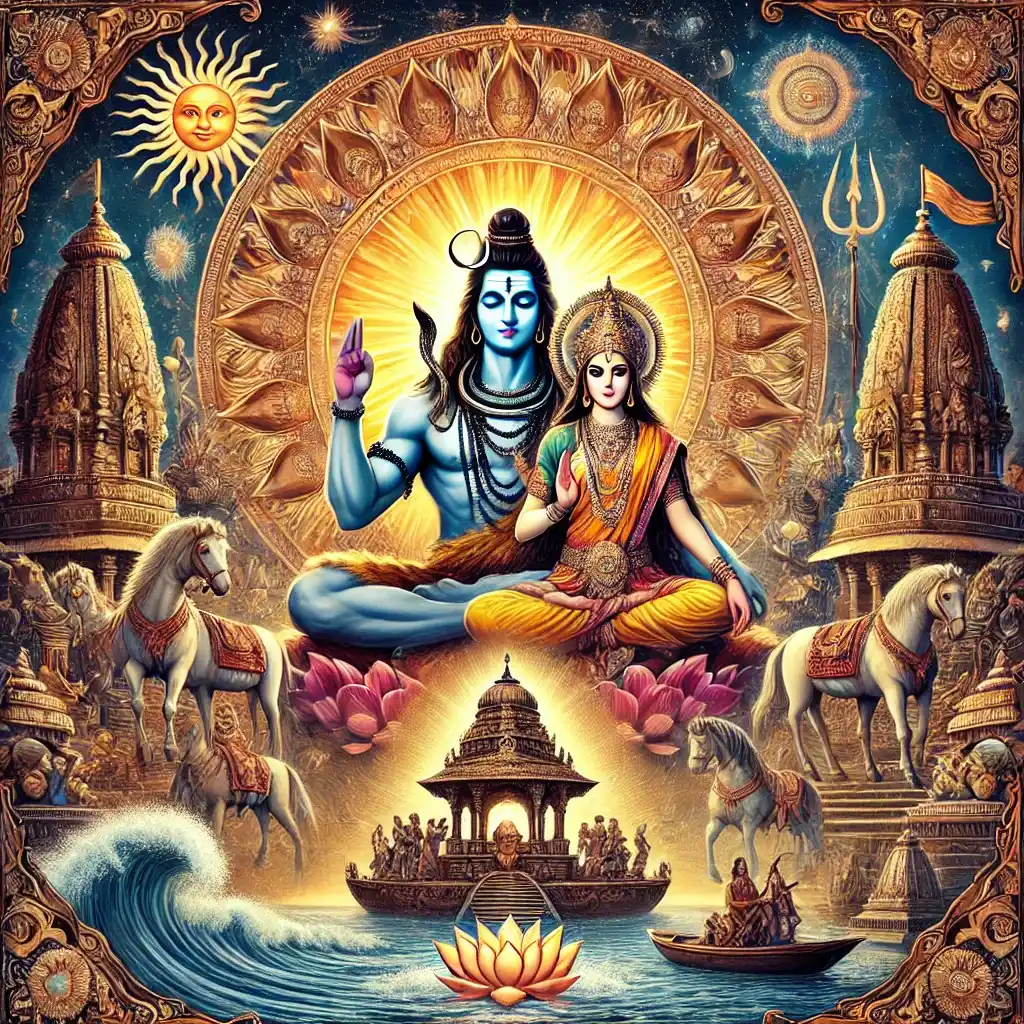
The Puranas
Saura Purana
Saura Purana: An In-Depth Exploration of Its Origins, Mythological Stories, Rituals, Worship Practices, Varanasi's Significance, and Its Role in Hindu Philosophy and Culture
The Saura Purana is one of the lesser-known yet profoundly significant texts within the vast and diverse corpus of Hindu religious literature. It belongs to the category of Upapuranas, which are secondary or minor Puranas that complement the eighteen major Puranas. This scripture offers a unique perspective on Hindu theology, combining narratives, rituals, and philosophical discourses to provide valuable insights into Hinduism's syncretic nature. The Saura Purana is particularly notable for its emphasis on the worship of Lord Shiva and his consort Parvati, while also being proclaimed by Surya, the Sun God. This blend of Shaiva and solar elements highlights the harmonious coexistence of various devotional traditions within Hinduism.
Origins and Classification
The term "Upapurana" refers to a group of scriptures considered secondary in stature compared to the Mahapuranas but no less significant in their theological and cultural contributions. The Saura Purana is classified as one of these Upapuranas and is traditionally associated with the Shaiva tradition due to its primary focus on Lord Shiva and Parvati. However, its attribution to Surya as the narrator is an intriguing feature that underscores the text's broader appeal and syncretic nature.
The origins of the Saura Purana are shrouded in the mists of time, like most ancient Hindu texts. Scholars believe it was composed between the 8th and 12th centuries CE, a period marked by vibrant theological developments and inter-sectarian debates within Hinduism. This historical context is reflected in the Purana's content, which not only celebrates Shiva and Surya but also engages with prevailing philosophical and theological currents. The Saura Purana’s association with both Shaiva and solar traditions makes it an important text for understanding the fluid and inclusive nature of Hindu devotional practices.
Structure and Content
The Saura Purana is an extensive work, comprising 69 chapters that cover a diverse range of topics. These chapters weave together hymns, stories, rituals, and philosophical discourses, creating a rich tapestry of religious and cultural themes. Below is a detailed exploration of its primary content areas:
Eulogies of Shiva and Parvati: A significant portion of the Saura Purana is devoted to glorifying Lord Shiva and Parvati. These eulogies underscore their roles as the ultimate cosmic powers responsible for creation, preservation, and destruction. Shiva is celebrated not only as the ascetic yogi but also as the compassionate benefactor who grants moksha (liberation) to his devotees. Parvati, as the divine mother and Shakti (power), is venerated for her nurturing and protective qualities. The text presents detailed rituals and prayers for worshipping Shiva and Parvati, emphasizing the transformative power of devotion.
Praise of Varanasi: One of the standout features of the Saura Purana is its detailed praise of Varanasi (Kashi), one of the holiest cities in Hinduism. The Purana extols the city’s sacred geography, describing its numerous shrines, lingas (symbolic representations of Shiva), and holy sites. Varanasi is portrayed as the spiritual capital of the world, where liberation is guaranteed to those who die or perform rituals there. The text offers a vivid account of the city’s spiritual significance, making it an invaluable resource for understanding the role of pilgrimage in Hinduism.
Narratives and Mythological Tales: The Purana includes several mythological stories, enriching its theological and cultural dimensions. One of the notable tales is that of Urvashi and Pururavas, found in chapter 31. This story explores themes of love, separation, and the complexities of human-divine relationships. Such narratives not only entertain but also convey moral and spiritual lessons, making the Purana accessible and engaging for its readers.
Devi Worship: The worship of the Goddess (Devi) occupies a prominent place in the Saura Purana. The text provides detailed guidelines for performing rituals dedicated to Devi, highlighting her role as the ultimate source of power and compassion. This focus on Devi worship aligns with the broader Hindu recognition of the divine feminine as an integral aspect of cosmic balance.
Merits of Donations and Vows: The Saura Purana emphasizes the spiritual benefits of engaging in charitable acts (dānas) and observing religious vows (vratas). It outlines specific practices and their corresponding rewards, encouraging devotees to lead a life of righteousness and selflessness. These sections serve as practical guides for adherents seeking spiritual growth and divine blessings.
Critique of Madhvacharya: An intriguing aspect of the Saura Purana is its critique of the philosopher Madhvacharya and his doctrines, found in chapters 38 to 40. This section reflects the theological debates of the time and provides insights into the dynamic intellectual environment within Hinduism. The inclusion of such critiques highlights the Purana’s role as both a religious and philosophical text.
Relationship with the Brahma Purana
The Saura Purana identifies itself as a supplement (khila) to the Brahma Purana, one of the major Puranas in Hindu literature. This connection suggests that the Saura Purana was intended to complement or expand upon the themes explored in the Brahma Purana, particularly those related to solar worship. By associating itself with a Mahapurana, the Saura Purana underscores its significance within the Puranic tradition.
Editions and Manuscripts
The preservation and dissemination of the Saura Purana have been facilitated through various manuscripts and printed editions. Notable among these are: The Anandashrama Sanskrit Series edition (1889), edited by Kasinath Sastri Lele, which provided a critical edition of the text. The Vangavasi Press edition (1908), which included a Bengali translation, making the text accessible to a broader audience. These editions have played a crucial role in bringing the Saura Purana to the attention of scholars and practitioners, ensuring its continued relevance in the modern era.
Significance in Hindu Tradition
The Saura Purana holds a unique place within Hinduism for several reasons:
Theological Diversity: By blending Shaiva and Saura elements, the Purana exemplifies the syncretic nature of Hinduism. It celebrates the coexistence of various deities and traditions, demonstrating how different streams of devotion can harmoniously integrate into a unified spiritual framework.
Cultural Insights: The detailed descriptions of Varanasi and its sacred sites offer valuable cultural and historical insights. The Purana serves as a window into the spiritual geography of ancient India, highlighting the enduring significance of pilgrimage and sacred spaces.
Philosophical Discourse: The text’s engagement with contemporary theological figures, such as Madhvacharya, provides a glimpse into the vibrant philosophical debates that have shaped Hindu thought. These sections underscore the dynamic and evolving nature of Hinduism as a living tradition.
Conclusion
The Saura Purana is a testament to the rich tapestry of Hindu religious literature. Its unique blend of devotion, narrative, and critique reflects the multifaceted nature of Hinduism, where diverse beliefs and practices coexist and complement each other. For modern readers, the Saura Purana offers a fascinating exploration of theological, cultural, and philosophical themes, making it a valuable resource for understanding the depth and breadth of Hindu tradition.

Explore the latest and most popular products available on Amazon, handpicked for your convenience! Whether you're shopping for tech gadgets, home essentials, fashion items, or something special, simply click the button below to view the product on Amazon. We’ve partnered with Amazon through their affiliate program, which means that if you make a purchase through this link, we may earn a small commission at no extra cost to you. This helps support our site and allows us to continue providing valuable content. Thank you for your support, and happy shopping!